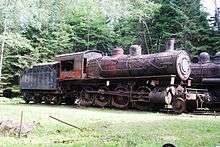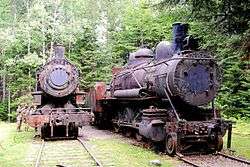Eagle Lake and West Branch Railroad
The Eagle Lake and West Branch Railroad was a forest railway built to transfer pulpwood between drainage basins in the Maine North Woods. The railroad operated only a few years in a location so remote the steam locomotives were never scrapped and remain exposed to the elements. Its tracks were located in Penobscot County and Piscataquis County
| Overview | |
|---|---|
| Locale | North Maine Woods region, Penobscot County and Piscataquis County Maine |
| Dates of operation | 1927–1933 |
| Technical | |
| Track gauge | 4 ft 8 1⁄2 in (1,435 mm) standard gauge |
| Length | 13 miles (21 km)[1] |
History
Spruce forests of the Maine North Woods were a source of pulpwood throughout the 20th century. Trees were bucked into 4-foot (1.2-meter) lengths and loaded onto sleds towed by draft animals or log haulers to the nearest river or lake. Log drives would float the pulpwood logs to a downstream paper mill when the snow and ice melted.[2] Pulpwood harvested in the upper Allagash River drainage was destined for Great Northern Paper Company paper mill on the West Branch Penobscot River in Millinocket. The problem was getting the pulpwood out of the north-flowing Allagash River into the east-flowing Penobscot River.
Umbazooksus and Eagle Lake Railroad
During the winter of 1926-27, Édouard Lacroix's Madawaska Company used log haulers to move heavy railway equipment overland from Lac-Frontière, Quebec to Churchill Depot and then over frozen Churchill Lake and Eagle Lake. The log haulers delivered two steam locomotives, two Plymouth gasoline-powered switchers, miles of steel rail, and sixty railroad cars for carrying pulpwood. Each railroad car was 32 feet (9.7 m) long with high, slatted sides to hold 12 cords of pulpwood. Three diesel-powered conveyors were built to lift pulpwood logs from Eagle Lake to a height of 25 feet (7.6 m) over a distance of 225 feet (68 m). Each conveyor could fill a railroad car in 18 minutes.[3] Lacroix completed the Umbazooksus and Eagle Lake Railroad to a pulpwood-unloading trestle at the north end of Umbazooksus Lake.[4] Lacroix's railroad included a 1500-foot (460 m) long trestle across the north end of Chamberlain Lake.
Great Northern Paper Company accepted Lacroix's railroad on 1 June 1927 and renamed it the Eagle Lake and West Branch Railroad.[5]
Operations
Supplies to operate the railroad arrived from the opposite direction. National railway system deliveries to Greenville, Maine were transported over 45 miles of road, and then across Chesuncook Lake on the side-wheel steamboat A. B. Smith.[2] Great Northern Paper Company built the Chesuncook and Chamberlain Lake Railroad from the steam boat landing at the north end of Chesuncook Lake along the eastern shore of Umbazooksus Lake to the pulpwood unloading pier at the north end of Umbazooksus Lake.[4] Both steam locomotives had been converted to burn oil, so drums of petroleum products to fuel the pulpwood conveyors, switchers and steam locomotives became a major freight commodity over Chesuncook Lake.[5]
Routine operations involved two trains moving ten or twelve loaded pulpwood cars south from Eagle Lake to Umbazooksus Lake, and empty pulpwood cars northward in a round trip taking about 3 hours. The two trains would pass at a midpoint siding. One Plymouth switcher shunted loading cars at Eagle Lake and the other shunted unloading cars at Umbazooksus Lake. The inland rail of the 600-foot (180 m) long pulpwood-unloading pier was six inches (15 cm) higher than the lakeside rail to expedite unloading. The floor of each pulpwood car sloped 12 inches (30 cm) to the unloading side; and the slatted side of the car was hinged at the top to swing open when latches were released so the pulpwood would slide out of the car into Umbazooksus Lake. Bark breaking off the pulpwood logs accumulated so the Plymouth switcher periodically dragged a rake adjacent to the pier to keep the water deep enough to float the pulpwood logs being dumped. Normal operations transferred 6,500 cords of pulpwood per week[5] enabling Great Northern Paper Company to manufacture approximately one-fifth of the United States' annual paper production.[2]
Demise
Paper demand declined through the Great Depression until pulpwood transfer ceased in 1933 after the railroad had carried nearly a million cords of pulpwood.[3] The Plymouth switchers found work elsewhere while the steam locomotives waited in the engine house for improved economic conditions. Great Northern found trucks more cost effective than restoring the railroad when business returned following World War II. The trestle gradually collapsed into Chamberlain Lake, but Maine Forest Service employees continued using a motor vehicle over the two miles of track between Eagle Lake and Chamberlain Lake.[6]
.jpg)
The engine house became a popular snowmobile destination in the 1960s;[7] and fittings like gauges, bells, headlights, and number plates began to disappear from the locomotives before the wooden cab of engine #1 was destroyed when the engine house burned in 1969.[8] The locomotive boiler jackets and asbestos lagging were removed in 1995 but the stripped locomotive shells remain a unique reminder of the industrial revolution in the Maine North Woods.[5]


Locomotives
| Number | Builder | Type | Date | Works number | Notes |
|---|---|---|---|---|---|
| 1 | Schenectady Locomotive Works | 4-6-0 | 1897 | 4552 | former New York Central Railroad (NYC) #63 class F53 built as Chicago Junction Railway #109; became Indiana Harbor Belt Railroad #109 in 1907, later #115[8] |
| 2 | Brooks Locomotive Works | 2-8-0 | 1901 | 4062 | former NYC #26 class G43a built as Lake Shore and Michigan Southern Railway #780, later #5780[8] |
References
- "Eagle Lake & West Branch Railroad". Richard N. Symonds, Jr. Retrieved 2012-12-20.
- "The Northern: The Way I Remember" (PDF). John E. Mcleod. Retrieved 2012-12-19.
- Pike, Robert E. Tall Trees, Tough Men W.W.Norton & Company (1999) ISBN 0393319172 p.164
- Rice, Douglas M. Log and Lumber Railroads of New England (3rd edition) The 470 Railroad Club (1982) -p.2
- "The Eagle Lake & West Branch Railroad". Maine Bureau of Parks and Lands. Retrieved 2012-12-19.
- Smith, Dwight A. Northern Rails (1967) p.15
- Erickson, Anne R. Snowmobile Rendezvous in Down East magazine pp.64&65
- Smith, Charles M. The Locomotives at Chamberlain Lake The 470 Club Newsletter (August, 1978) p.11
- Eagle Lake and West Branch Railroad Consolidation locomotive #2 Location 46.322445, -69.374989
- Eagle Lake and West Branch Railroad locomotives Location 46.322445, -69.374989